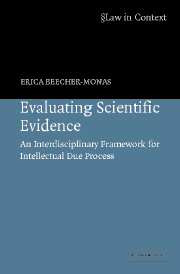Book contents
- Frontmatter
- Contents
- Acknowledgments
- Evaluating Scientific Evidence
- Introduction
- 1 Triers of science
- 2 What is intellectual due process?
- 3 A framework of analysis
- 4 Toxic torts and the causation conundrum
- 5 Criminal identification evidence
- 6 Future dangerousness testimony: The epistemology of prediction
- 7 Barefoot or Daubert? A cognitive perspective on vetting future dangerousness testimony
- 8 Future dangerousness and sexual offenders
- 9 Models of rationality: Evaluating social psychology
- 10 Evaluating battered woman syndrome
- Conclusion
- Index
- The Law in Context Series
1 - Triers of science
Published online by Cambridge University Press: 04 December 2009
- Frontmatter
- Contents
- Acknowledgments
- Evaluating Scientific Evidence
- Introduction
- 1 Triers of science
- 2 What is intellectual due process?
- 3 A framework of analysis
- 4 Toxic torts and the causation conundrum
- 5 Criminal identification evidence
- 6 Future dangerousness testimony: The epistemology of prediction
- 7 Barefoot or Daubert? A cognitive perspective on vetting future dangerousness testimony
- 8 Future dangerousness and sexual offenders
- 9 Models of rationality: Evaluating social psychology
- 10 Evaluating battered woman syndrome
- Conclusion
- Index
- The Law in Context Series
Summary
Scientific evidence is an inescapable facet of modern litigation. It is fundamental to criminal justice and to civil litigation. What counts as science, however, who gets to make this decision, and how they should go about it are all hotly contested. Nor is this contest limited to the United States. The issue of scientific reliability is a hot topic in England and other Commonwealth jurisdictions, as well as in continental European systems.
In the United States, legislatures, federal, and many state courts have placed the responsibility for evaluating the validity of scientific testimony squarely on judges. Other states continue to use a general-consensus standard for scientific validity, in which it is the scientific community that makes that decision. In those jurisdictions where judges must evaluate scientific validity, the result is that judges – traditionally triers of law, occasionally pressed into service as triers of fact – now must also be triers of science in cases where experts proffer scientific evidence.
Predictably, not everyone is pleased with this new state of affairs, and many question judicial competence in this area. Years after Daubert v. Merrell Dow Pharmaceuticals, Inc. and the subsequent amendments to the Federal Rules of Evidence made federal judges responsible for assessing scientific validity, judges and lawyers are still grappling with the fact that they can no longer merely count scientific noses but must instead analyze whether expert testimony meets the criteria of good science.
- Type
- Chapter
- Information
- Evaluating Scientific EvidenceAn Interdisciplinary Framework for Intellectual Due Process, pp. 4 - 16Publisher: Cambridge University PressPrint publication year: 2006

